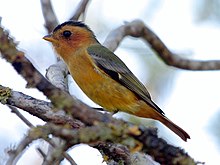Black-capped piprites
| Black-capped piprites | |
|---|---|
 |
|
| A male black-capped piprites at Campos do Jordão, São Paulo state, Brazil. | |
 |
|
| A female at Campos do Jordão, São Paulo state, Brazil. | |
| Scientific classification | |
| Kingdom: | Animalia |
| Phylum: | Chordata |
| Class: | Aves |
| Order: | Passeriformes |
| Family: | Incertae sedis |
| Genus: | Piprites |
| Species: | P. pileata |
| Binomial name | |
|
Piprites pileata (Temminck, 1822) |
|
| Synonyms | |
|
Piprites pileatus |
|
Piprites pileatus
The black-capped piprites (Piprites pileata), also known as the black-capped manakin, is a species of suboscine passerine. It has traditionally been placed in the manakin family, although it remains unclear if this is correct. It is therefore considered incertae sedis by recent authorities such as SACC.
It is found in Atlantic forest, especially with Araucaria angustifolia, growing in highlands of south-eastern Brazil and north-eastern Argentina (Misiones only). Until the recent rediscovery in Argentina, the only confirmed record for that country was a specimen taken in 1959. It is generally rare and local, and therefore considered vulnerable by BirdLife International. It is known from a number of protected areas, including the Itatiaia National Park in Rio de Janeiro, and Campos do Jordão State Park in São Paulo.
...
Wikipedia

